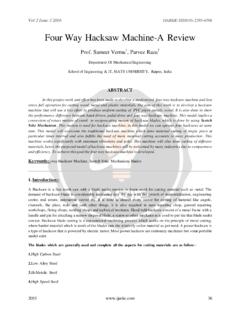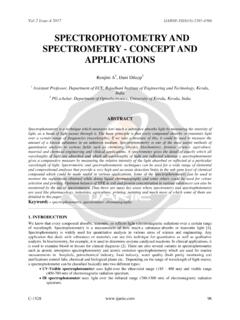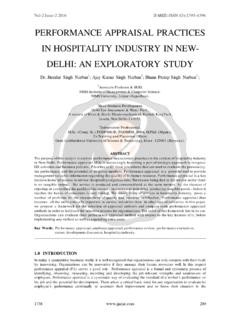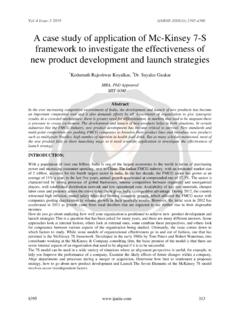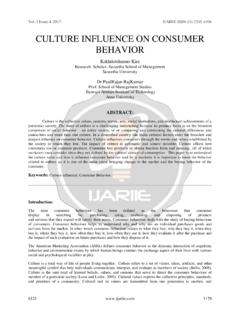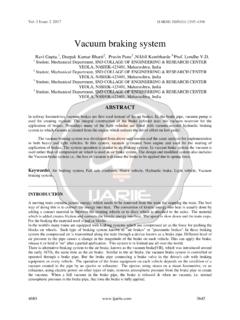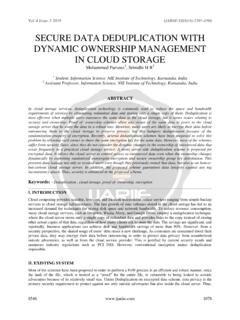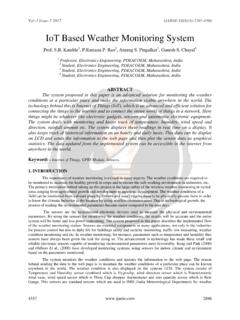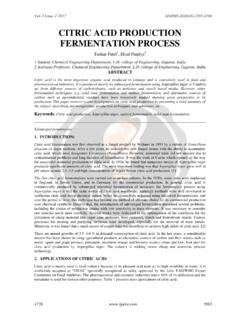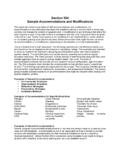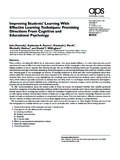Transcription of “Educational Thoughts of Dr. Sarvapalli Radhakrishnan”
1 Vol-2 Issue-3 2016 IJARIIE-ISSN(O)-2395-4396. Educational Thoughts of Dr. Sarvapalli Radhakrishnan . Mr. Panasa Adinarayana , ABSTRACT. One of India's most influential scholars of comparative religion and philosophy, Dr. S. Radhakrishnan is considered through his efforts to have built a bridge between the East and the West by showing that the philosophical systems of each tradition are comprehensible within the terms o f the other. To him, philosophy was a way of understanding life and his study of Indian philosophy served as a cultural therapy. By interpreting Indian thought in Western terms and showing that it was imbued with reason and logic he was able to give Indians a new sense of esteem, who were overcome by inferiority complex by i mperial forces. But he also made clear to them that their long and rich tradition had been arrested and required further evolution and he exhorted Indians to cast off much that was corrupt and abhorrent.
2 Pandit Jawaharlal Nehru, who was one of his closest friends thro ughout, said about Dr. Radhakrishnan: he has served his country in many capacities. But above all, he is a great teacher from whom all of us have learnt much and will continue to learn. It is India's peculiarity in itself showing the kind of men we honour and respect. A Brief bio-graph of Dr Sarvepalli: Dr. Radhakrishnan was born into a middle class Telugu Brah min family at Tirutani in Tamil Nadu state. A. town in Madras Presidency, Brit ish India, 64 km to the northwest of Madras (now Chennai). His early years were spent in Tirutani and Tirupati. His father was a subordinate revenue official in the service of a local Zamindar (. landlord).He d idn't want his son to learn English, instead wanted him to become a priest.
3 His primary education was at Primary Board High School at Tirutani. In 1896 he moved to the Hermansburg Evangelical Lutheran Mission School at Tirupati. Dr. Radhakrishnan was awarded scholarships throughout his academic life. He joined the Voorhee's College in Vellore but switched over to the Madras Christian Co llege at the age of 17. He g raduated with a Master Degree in Ph ilosophy from the Madras Christian Co llege in 1906, being one of its most distinguished alu mni. Radhakrishnan wrote his thesis for the degree on Ethics of the Ve danta and its Metaphisical Presuppositions . He was affraid that his thesis, would offend his Philosophy Professor , Dr. Hogg. Instead , Dr. Hogg commended Radhakrishnan on doing an excellent job. Radhakrishnans thesis was published when he was only 20.
4 Radhakrishnan studied philosophy by chance rather than by choice. Being financially constrained student at that time, when a cousin, after graduating fro m the same co llege, passed on his textbooks in philosophy to Radhakrishnan, it automat ically decided his academic course. Later on he developed deep interest in h is subject and wrote many acclaimed works on philosophy, both astern and Western. Dr. Radhakrishnan stated that western philosophers, despite all claims to objectiv ity, were influence d by theological influences of their own cu lture. He wrote books of Indian philosophy according to Western academic standards, and made all efforts for the west to give serious consideration to Indian philosophy. In his book Idealist View of Life , he made a powerful case for impo rtance of intuitive thinking as opposed to purely intellectual forms of thought.
5 He is well known for his commentaries on the Prasthana Trayi namely, the Bhagavadgita, the Upanishads and the Brahma Sutra. Radhakrishnan was married to Sivakamu, a d istant cousin, in 1904 at the age of 16. As per tradition the marriage was arranged by the family. The couple had five daughters and a son, Sarvepalli Gopal .He went on to a notable career as a historian. Sivakamu died in 1956. They were married for over 51 years. In 1918 Radhakrishnan was selected as Professor of Philosophy by the University of Mysore. By that time he had written many articles for journals of repute like The Quest, Journal of Philosophy and the International Journal of Ethics. He also comp leted his first book, "the Philosophy of Rabindranath Tagore." He believed Tagore's philosophy to be the genuine manifestation of the Indian spirit.
6 Dr. Radhakrishnans second book, "the Reign of Religion in Contemporary Ph ilosophy" was pu blished in 1920. In 1921. he was appointed as a Professor in Philosophy to occupy the King George V Chair of Mental and Moral Science at 2762 4202. Vol-2 Issue-3 2016 IJARIIE-ISSN(O)-2395-4396. the University of Calcutta. Radhakrishnan represented the University of Calcutta at the Congress of the Un iversities of the Brit ish Emp ire in June 1926 and the International Congress of Ph ilosophy at Havard University in september 1926. In 1929 Dr. Radhakrishnan was invited to take the post vacated by Principal J. Estlin Carpenter in Manchester College, Oxfo rd . Th is gave him the opportunity to lecture to the students of the University of Oxford on Co mparative Religion. Fo r his services to education he was knighted by the British Goverment in 1931, but he never used the SR title in his personal life, prefering instead his academic tit le of was Vice - Chancellor of Andhra University from 1931 to 1936.
7 In 1936 Radhakrishnan was named Splading Professor of Eastern Relig ions and Ethics at the University of Oxford, and was selected a fellow of A ll Souls Co llege. In 1939 Pt. Madan Mohan Malavya invited him to succeed him as the Vice Chanceellor of Banaras Hindu University (BHU). He continued as its Vice Chancellor till January, 1948. When India became independent in 1947 , Dr. Radhakrishnan represented India at UNESCO and was later A mbassador of India to the Soviet Union, fro m 1949 to 1952. He was also elected to the Constituent Assembly of India. Along with Ghanashyam Das Birla and some other Social workers in the pre - independence era, Dr. Radhakrishnan formed the Krishnarpan Charity Trust. Dr. Radhakrishnan moved beyond being a more academic and sought to engage his philosophical and religious studies in the polit ical and social developments of the contemporary context.
8 He believed that in India, the philosopher's duty was to keep in touch with the past while stretching out to the future. His co mmit ment to society, the crusading urgent tone in his scholarly writ ings, the modern note in his interpretations of even classical texts and his intellectual resistance to the deforming pressures of colonialis m gave Dr. Radhakrishnan a distinct public image. He was a coin minted differently fro m the usual run of politicians and academicians. Far fro m being a stern and severe intellectual remote fro m the world, Dr. Radhakrishnan was a very hu mane person. Exceedingly popular among his students right from his early days as a Professor at Presidency College, Madras he was an evocative teacher. He was offered the professorship in Calcutta University when he was less than 30 years old.
9 His mastery on his subject and his clarity of thought and expression made him a much sought after teacher. But what made him even more popular was his warm heartedness and his ability to draw out people. This aspect of his personality continued to win him countless admirers throughtout his long and illustrious public life. In the last decade of Brit ish rule, his was the most sophisticated and exalted nalysis of Gandhi's work and thought and in free India he provided the ideological armour for Nehru's foreign policy. His commit ment to high princip les and unfilling d ignity and moral authority to all the offices which he held. If in India Dr. Radhakrishnan was highly respected figure, abroad he became one of the best - liked public figures of his time. He earned very early international recognition as a philosopher.
10 In 1952, the Library of Living Philosophers, an institute of world- wide repute, brought out a massive volu me on the philosophy of Sarvepalli Radhakrishnan, devoted wholly to a critical appreciat ion of his philosophical doctrines. After independence, this philosophical lu minary, who personified the essence of India yet had a universal vision, became an ideal ambassador to the Soviet Union, for the nascent nation poised to establish itself in the inte rnational arena. In 1952, Dr. Radhakrishnan was chosen to be the Vice President of the Republic of India and in 1962, he was made the Head of the State for five years. It was the glory of Indian democracy that educationist aloof fro m polit ics but having an International acclaim as a profound scholar was placed in the position of the President.
